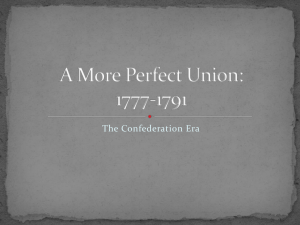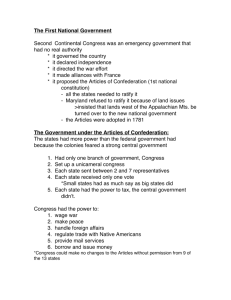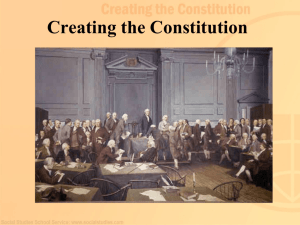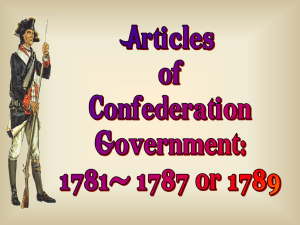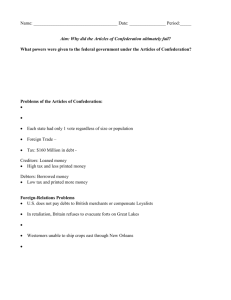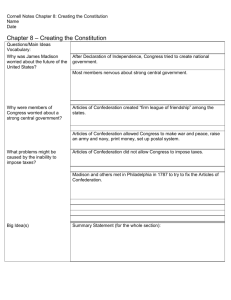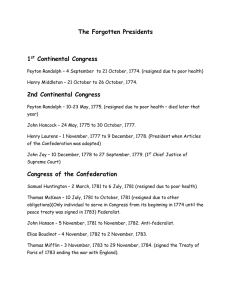A Critical Period? - Adams State University
advertisement
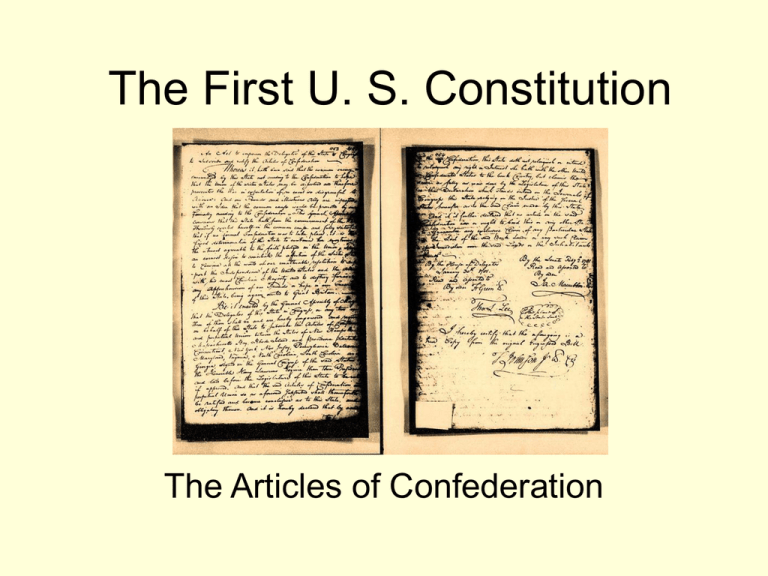
The First U. S. Constitution The Articles of Confederation Drafting the Articles • First drafted by John Dickinson, adopted by Congress in 1777; approved by states by 1781. • Big impediment for adoption was the debate over western lands; did large states with sea-to-sea charters get to keep their western lands? Md. wouldn’t ratify until NY and VA ceded lands—done in March 1781. Features of Articles-1 • Establishes the name of the confederation as "The United States of America." • Asserts the precedence of the separate states over the confederation government, i.e. "Each state retains its sovereignty, freedom, and independence, and every power, jurisdiction, and right, which is not by this Confederation expressly delegated." • Establishes the United States as a league of states united ". . . for their common defense, the security of their liberties, and their mutual and general welfare, binding themselves to assist each other, against all force offered to, or attacks made upon them . . . ." • Establishes freedom of movement–anyone can pass freely between states, excluding "paupers, vagabonds, and fugitives from justice." All people are entitled to the rights established by the state into which he travels. If a crime is committed in one state and the perpetrator flees to another state, he will be extradited to and tried in the state in which the crime was committed. • Allocates one vote in the Congress of the Confederation (United States in Congress Assembled) to each state, which was entitled to a delegation of between two and seven members. Members of Congress were appointed by state legislatures; individuals could not serve more than three out of any six years. Features of Articles-2 • Only the central government is allowed to conduct foreign relations and to declare war. No states may have navies or standing armies, or engage in war, without permission of Congress (although the state militias are encouraged). • When an army is raised for common defense, colonels and military ranks below colonel will be named by the state legislatures. • Expenditures by the United States will be paid by funds raised by state legislatures, and apportioned to the states based on the real property values of each. • Defines the powers of the central government: to declare war, to set weights and measures (including coins), and for Congress to serve as a final court for disputes between states. • Defines a Committee of the States to be a government when Congress is not in session. • Requires nine states to approve the admission of a new state into the confederacy; pre-approves Canada, if it applies for membership. • Reaffirms that the Confederation accepts war debt incurred by Congress before the Articles. • Declares that the Articles are perpetual, and can only be altered by approval of Congress with ratification by all the state legislatures. Presidents of the United States in Congress Assembled • • • • • • • • • • Samuel Huntington (March 1, 1781 – July 9, 1781) Thomas McKean (July 10, 1781 – November 4, 1781) John Hanson (November 5, 1781 – November 3, 1782) Elias Boudinot (November 4, 1782 – November 2, 1783) Thomas Mifflin (November 3, 1783 – October 31, 1784) Richard Henry Lee (November 30, 1784 – November 6, 1785) John Hancock (November 23, 1785 – May 29, 1786) Nathaniel Gorham (June 6, 1786 – November 5, 1786) Arthur St. Clair (February 2, 1787 – November 4, 1787) Cyrus Griffin (January 22, 1788 – November 2, 1788) The Articles of Confederation • Since they were replaced, most have focused on its weaknesses, but under the articles, there were important achievements: • Peace with Britain was secured (Treaty of Paris, 1783) • Western Land and Territorial Policy was developed (Land Ordinance of 1785, Northwest Ordinance of 1787) Land Ordinance of 1785 • Survey and Sale • Public Land into Private Hands Northwest Ordinance • • • • • • • Abolition of state claims Admission of new states Establishment of territorial government Establishment of civil rights Prohibition of slavery Definition of the Midwest as a region Effects on Native Americans

